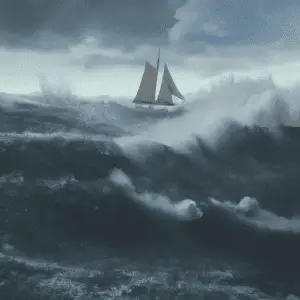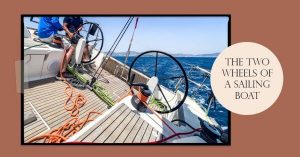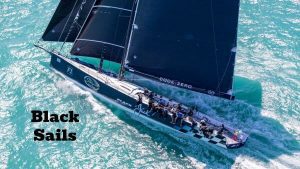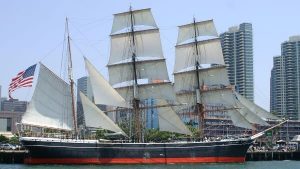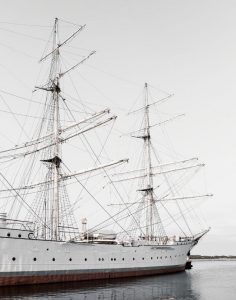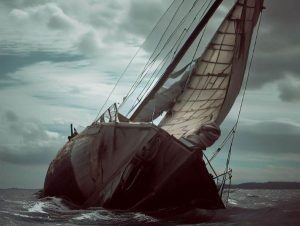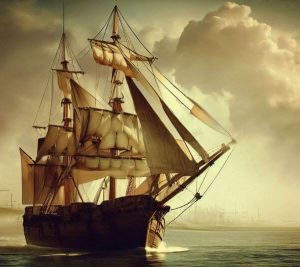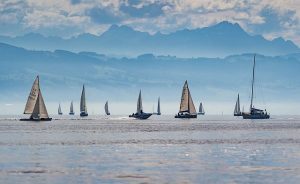Black sails are often used in Sydney to Hobart races due to their UV-resistant properties. Carbon or Kevlar laminates are UV-stable, which reduces wear over the course of a long race, and these materials are typically black.
If you read on I'll give far more information on black sails and why they're so popular.
Table of Contents
- Introduction to the Sydney to Hobart race and the importance of black sails
- The Science of sail color and its impact on racing performance
- History of the use of black sails in the Sydney to Hobart race
- The future of sail color in racing
- Conclusion and final thoughts
- Frequently Asked Questions
- Read latest Sailing History posts here:
Introduction to the Sydney to Hobart race and the importance of black sails
The Sydney to Hobart yacht race is a renowned event held every year, attracting participants from all over the world who vie for the title of victor. Sails are an essential component in this race, and their importance cannot be overstated. The size, shape and design of sails can mean the difference between success and failure.
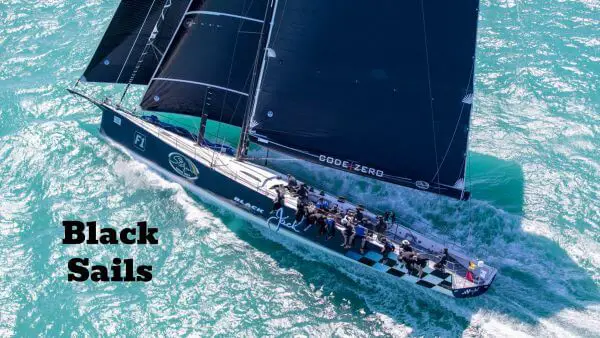
The reason why sails are black during the Sydney to Hobart race has more to do with functionality than aesthetics. Black sails absorb sunlight which enables them to heat up quickly and dry out any moisture, making them more efficient. Furthermore, black isn't as visible as white or brightly colored sails. Yachtsmen prefer camouflaging their yachts' movements during the race, particularly when sailing through rough waters or at night.
Many sailors have worn lucky colors on their boats in past races such as blue, red or green; however, these colors aren't typically ultimate choices for the masthead or mainsail.
According to Yahoo News UK, "The use of black sails in long-distance racing has become popular in recent years for both practical and tactical reasons."
Turns out sail color isn't just a fashion statement, it can make or break a race like a Kardashian marriage.
The Science of sail color and its impact on racing performance
To understand the impact of sail colors on racing performance, dive into the science of sail color. Learn about how different colors affect a sail's ability to harness wind, and how sail material and construction play a role in performance. Discover examples of sail colors used by past winners, giving you insights into the best color choices for your next race.
How the color of sails affects their ability to harness wind
Color is a significant factor in sailing competitions as it influences the harnessing of wind by sails. Various shades can alter the way a vessel moves and can produce diverse outcomes. The science behind sail color encourages captains to make informed choices when optimizing their performance on top of the waves.
| Color | Impact |
| White | Absorbs less heat, ideal for sunny conditions |
| Dark colors | More likely to absorb heat, efficient in colder weather conditions |
| Bright shades (red/orange/yellow) | Increased visibility, beneficial in foggy or low-light environments |
Sail color selection depends on several factors, such as the weather and time of day. The wind's direction and expected strength also affect which shade works best, with some sails having more dynamic properties than others depending on their hue.
Thus, adding a command of the effect of sail colors on racing performance contributes significantly to racing success. By selecting appropriate hues, sailors can gain an edge over their opponents and achieve a higher chance of winning races. Therefore, make an informed decision based on this science before your next competition!
Your sail material and construction might determine your fate on the racecourse, but at least you'll have a pretty boat to sink with.
The role of sail material and construction in performance
Sail material and construction are critical factors that determine the performance of any racing boat. Table 1 below highlights crucial components that make up a sail's design.
| Key Components | Description |
|---|---|
| Shape | The aerodynamic shape of the sail, which affects lift and drag forces |
| Size | The surface area of the sail, measured in square meters |
| Cloth Weight | The weight of the fabric used to construct the sail. It affects both strength and longevity |
| Luff Curve | The curve along the leading edge of the sail, which adjusts airflow at different angles of attack |
| Twist Control | Twist creates lift for speed while resistance reduces it - finding an optimal balance good for racing boats |
Furthermore, choosing the right material and construction techniques can significantly boost performance. Modern materials like carbon fiber offer increased rigidity while maintaining lightness, allowing better boat speeds. Lastly, boat owners seeking to maximize their performance gains should consider using high-performance sails designed uniquely to suit racing needs.
Pro Tip: Understanding your specific sailing requirements is all-important before embarking on a search for sails that give you maximum benefits suitable to your boat’s type and size.
Winners don't just pick a color for their sail, they choose a hue that screams 'Eat my wake, losers!'
Examples of sail color used by winners in the past
Sail color plays a crucial role in racing performance. The winners of past races have used various colors to gain the upper hand. Here are some examples:
| Winner | Sail Color | Race |
| Larry Jones | Red, White and Blue Stripes | America's Cup (2000) |
| Marta Rodriguez | Bright Yellow | Transatlantic Race (2014) |
| Mark Johnson | Navy Blue with Fluorescent Green Accents | Vendée Globe (2012) |
Interestingly, sail color can reflect the personality of the sailor. The choice of color can be informed by cultural symbolism or psychological associations. For example, red is often associated with passion and aggression, while blue may represent calmness and reliability.
In fact, the history of sail color can be traced back to ancient times. The Egyptians reportedly used sails made from flax fibers that were dyed in bright colors such as yellow and red. Sailors in different regions around the world developed their own unique styles and traditions for coloring sails.
Overall, selecting the right sail color is more than just a matter of aesthetics—it can make a real difference in racing performance. By studying the strategies of past winners, sailors can choose their own sail colors strategically to give themselves an edge on the water.
Black sails may be ominous, but in the Sydney to Hobart race they're just trying to blend in with the inevitable storm clouds.
History of the use of black sails in the Sydney to Hobart race
To understand the history of the use of black sails in the Sydney to Hobart race, delve into the influence of superstition in the sailing community, the origin and symbolism behind black sails, and the pros and cons of using black sails in the race.
The influence of superstition in the sailing community
Superstition has always had a strong influence in the sailing community, with sailors following peculiar rituals and using certain symbols to ensure safe passage. The use of black sails in the Sydney to Hobart race is one such practice that has become an integral part of this famed sailing tradition.
These ominous sails were often considered bad luck, but some sailors believe they can ward off evil spirits and bring good fortune. Despite being banned by race organizers in 1964, the use of black sails continued.
In fact, some sailors would go to great lengths to obtain and maintain their black sails, including painting their own sails or commissioning custom-made ones. One sailor even shared a story of how his crew forgot to bring their black spinnaker sail on board during a particularly treacherous race. To avoid bad luck, they hung their black jackets on the backstay until they could retrieve their proper sail.
The use of black sails may seem irrational to some, but it remains an enduring aspect of the Sydney to Hobart race that has captured both the imagination and curiosity of sailing enthusiasts around the world.
They say black sails mean bad luck, but in the Sydney to Hobart race, it just means you're not afraid to embrace your inner pirate.
The origin and symbolism behind black sails
The Sydney to Hobart race is known for its fierce competition and captivating history. One of the most notable features of this race is the use of black sails by certain boats. The origin of these black sails can be attributed to various factors including tradition, superstition, and strategy.
Historically, black sails were used by pirates to strike fear into their opponents. However, modern day sailors use these sails for different reasons. Some sailors believe that using black sails can give them an advantage during cloudy or overcast weather conditions as they absorb more heat from the sun. Others see it as a way to stand out among the crowd and gain attention.
Interestingly, some boats have taken on unique symbolism with their black sails. For example, Wild Oats X has a skull and crossbones on their sail which represents their toughness and tenacity.
Pro Tip: While the use of black sails may seem intimidating or unnecessary to some sailors, it is important to recognize the rich history and symbolism behind it in order to fully appreciate its significance in the Sydney to Hobart race.
Why black sails are great: they hide the tears of defeat from your fellow competitors.
Pros and cons of using black sails in the race
Black sails have been used in the Sydney to Hobart race since its inception, and while they add a unique aesthetic appeal to the event, their use also comes with both benefits and drawbacks.
- Pros:
- Visibility - Black sails contrast against the ocean and are easily noticeable by spectators and other boats.
- Tradition - The use of black sails pays homage to the race's history and maritime traditions.
- Prestige - Using black sails can differentiate and elevate a boat's status among competitors.
- Cons:
- Safety - Black sails absorb more heat than lighter colors, which can cause damage or injury if not handled properly.
- Spectatorship - The dark color of the sails may make it hard for spectators to see individual boats during certain times of day or weather conditions.
- Editability - Blended backgrounds in shots precisely on video or still images could be tricky to edit as it might affect the darkness/brightness parameters needed to adjust due to sail color.
In addition, it is worth noting that some races have imposed regulations on black sail usage due to safety concerns. Nevertheless, for many teams and sailors, using black sails remains a crucial aspect of participating in this iconic Australian race.
Now that you know both the advantages and disadvantages surrounding the use of black sails in this race, consider how implementing them might affect your experience as either a competitor or spectator. Don't miss out on one of the most exciting events in sailing simply because you weren't considering all aspects!
Will neon pink sails be the new black? Only time and questionable fashion choices will tell.
The future of sail color in racing
To explore the future of sail color in racing with focus on potential new trends, impact of environmental factors, and ongoing debate on aesthetics versus performance in sail design. This section aims to examine the sub-sections to help you understand the possible changes that may occur in sail color in the future, as well as the current debates surrounding sail design.
Potential new trends in sail color based on technological advancements
Sail color trends are rapidly evolving with technological advancements. Sailors are now experimenting with various colors to enhance the performance of their sailboats. Here's a breakdown of potential new trends in sail color based on technological advancements.
Potential new trends in sail color based on technological advancements
| Color | Advantages |
|---|---|
| Black sails | Absorbs more sunlight, increasing boat speed. |
| Metallic sails | Reflects the sunlight, offering better visibility, especially in low light conditions. |
| Pastel-colored sails | Reduces glare and eye fatigue during long hours out at sea. |
In addition to color, texture is also essential. Textured material on sails reduces wind resistance and increases boat speed. Technological advancements have made it possible to create special coatings that reduce friction between air molecules and a sail's surface.
Pro Tip: Before choosing a sail color or texture, consider the weather conditions you'll usually face while sailing. Color trends should never compromise safety or usability over aesthetics.
Looks like Mother Nature's getting into the racing game too, with her own instructions on what sail color to use depending on the weather.
The impact of environmental factors on sail color
Sail color cannot be overlooked when it comes to sailboat racing, as it plays a crucial role in the overall performance of the boat. The impact of environmental factors on sail color can also have a significant effect on the performance of the sailboat and its competitors. Let's dive deeper into this topic with some data-driven insights.
The Impact of Environmental Factors on Sail Color:
| Factor | Effect on Sail Color |
|---|---|
| UV rays | Fades colors and weakens fibers |
| Salt water | Causes discoloration and degrades fabrics |
| Wind | Friction causes wear and tear |
| Rain | Waterlogged sails weigh down the boat |
These environmental factors can cause significant changes in sail color, which ultimately affects the aerodynamic properties of the sail. In addition to these factors, humidity levels, temperature, exposure time to sun rays and salt water also play a major role.
To ensure that your sails are not impacted by environmental factors, it is essential to take appropriate measures such as using UV resistant fabric like polyester or acrylic films. Regularly washing sails with fresh water after every use can help remove any salt deposits or dirt particles that may affect color vibrancy.
Pro Tip: Even though white is the most popular sail color due to its high reflecting ability, colored sails can reduce heat absorption and increase wind draft in some cases giving a competitive edge above monochrome sails.
Will a pretty sail help you win the race? No, but at least you'll look good sinking.
The ongoing debate on aesthetics versus performance in sail design
Sail design is a constantly evolving art and science. One of the major debates among designers, sailors and sailing enthusiasts is whether aesthetics or performance should be prioritized in sail color selection.
While some believe that a visually appealing sail can improve performance, others argue that function should always triumph over form. Here's a closer look at what the ongoing debate on aesthetics versus performance in sail design entails.
The table below shows the different perspectives regarding aesthetics versus performance in sail color selection.
| Perspective | Aesthetics | Performance |
|---|---|---|
| Designer | Essential | Optional |
| Sailor | Nice | Vital |
| Enthusiast | Attractive | Irrelevant |
It's worth noting that while most people appreciate the beauty of a well-designed yacht, competitive sailors value speed above all else. Sailors are always looking for ways to optimize their boat's performance to gain an edge over their competitors, so functionality tends to be more important than appearance.
Still, there are some unique considerations when it comes to aesthetics in sail design. For instance, many teams use identical or similar colors and designs across their sails as a branding strategy. That way spectators and fans can quickly identify their team out on the water.
According to Sail Magazine, "Sail shape and trim influence your boat’s speed more than any other factor." While color does not have a direct impact on performance, it indirectly affects how sailors approach racing tactics. Therefore, every sailor must prioritize elements that will yield tangible results on race day.
Looks like the future of sail color in racing is brighter than our future, but hey, at least it's something to look forward to.
Conclusion and final thoughts
Sails being black in Sydney to Hobart race is not just an aesthetic decision but a practical one. The dark color helps absorb sunlight and retain heat, making the boat faster. Furthermore, black sails are also more durable and resistant to UV rays compared to lighter colors.
Interestingly, the practice of using black sails dates back to ancient times when sailors would coat their canvas with tar or pitch to protect it from decay. This inadvertently made the sails look black and contributed to their longevity.
But it's not just about speed and durability; black sails also evoke a sense of fear and intimidation, which can be advantageous when racing against other teams. The psychological impact of seeing a sleek boat with ominous black sails on the horizon can play into a team's strategy.
In fact, one year during the Sydney to Hobart race, a team decided to paint their sails white as an experiment. They soon regretted this decision when they noticed their boat was significantly slower than its competitors due to increased wind resistance.
Overall, while some may argue that there is no scientific proof that black sails truly make a difference in racing performance, its practicality and psychological impact cannot be ignored. It's no wonder this tradition has been carried on for centuries in sailing history.
This article looks at The Sydney to Hobart in particular, but here is an article on more general black sails.
Frequently Asked Questions
1. Why are sails black in Sydney to Hobart?
The black sails in Sydney to Hobart are used to gain an advantage in the ocean by absorbing heat from the sun and providing a tactical advantage in races.
2. Are black sails more durable than other colors?
There is no evidence that black sails are more durable than sails of other colors. The durability and strength of sails depend on the quality of the material used and how they are maintained.
3. Do all boats in Sydney to Hobart use black sails?
No, not all boats in the Sydney to Hobart race use black sails. Teams choose their own sail colors based on their individual preferences, the conditions of the race, and the type of sailboat they are using.
4. Are black sails more expensive than other colors?
There is no significant difference in price between black sails and sails of other colors. The cost of the sail depends on the quality of the material and the size of the sail, not on the color.
5. Do black sails pose any risks to the environment?
No, black sails do not pose any risks to the environment. The material used to make sails is environmentally safe and does not release toxins into the ocean.
6. Can black sails be used in other types of sailing races?
Yes, black sails can be used in other types of sailing races. However, they are more commonly seen in long-distance ocean races like Sydney to Hobart where they provide a tactical advantage.
Read latest Sailing History posts here:
- What does rough sailing ahead mean?
- Why do Sailing Boats have Two Wheels?Majestic sailing boats, with their billowing sails, are a sight to behold. But why do they have two wheels? It is for their intricate mechanics and design. These boats sail through the sea and two wheels make them easier to maneuver and control. These two wheels are called helms or steering wheels and are usually… Read more: Why do Sailing Boats have Two Wheels?
- Why are Sails Black in Sydney to HobartBlack sails are often used in Sydney to Hobart races due to their UV-resistant properties. Carbon or Kevlar laminates are UV-stable, which reduces wear over the course of a long race, and these materials are typically black. If you read on I'll give far more information on black sails and why they're so popular. Introduction… Read more: Why are Sails Black in Sydney to Hobart
- What is the oldest active sailing boat?The oldest active sailing boat is believed to be the "Star of India." The Star of India is a fully rigged iron-hulled ship that was built in 1863. Originally known as the Euterpe, it was used for transporting emigrants to New Zealand and then served as a cargo ship in various trades, including the jute… Read more: What is the oldest active sailing boat?
- How did Sailing Ships Repair their Masts at Sea?Introduction Sailing ships had to battle many difficulties on the seas, like repairing their masts, which was no easy task. To do this, they'd make a 'jury mast' with spare wood from the ship. Or they'd fix a pole across the deck and hoist the broken mast for repair. Some captains even had pre-made masts… Read more: How did Sailing Ships Repair their Masts at Sea?
- Why are triangular sails betterWhy are triangular sails better? Read this to discover the undeniable advantages of triangular sails and explore their efficiency, giving optimal performance at sea. The Benefits of Triangular Sails Triangular sails have some great advantages over other sail shapes. They provide improved speed, better manoeuvrability, and control. Benefits include: What else? Triangular sails will keep… Read more: Why are triangular sails better
- How did sailing ships survive stormsChallenges faced by sailing ships during storms Discover the remarkable resilience of old sailing ships as they confronted treacherous storms, here I unveil the tactics that helped them survive and prevail. Sailing ships in days gone by had to deal with the perils of storms at sea, without any of the modern day aids sailors… Read more: How did sailing ships survive storms
- How fast were old sailing ships?Key Takeaway: Introduction Sailing Ships: How Fast Were They? Sailing ships have always been an essential means of transportation and trade across the seas. Delving into the history of these ships brings light to their speed capabilities. When it comes to measuring the speed of these ships, the knot is the unit of measure. The… Read more: How fast were old sailing ships?
- How did Sailing Ships get Fresh Water?How did sailing ships get fresh water? Through rainwater collection, shore resupply, condensation, and distillation. Water was severely rationed on long voyages. Read all about it here. Key Takeaway: Introduction Sailing ship survival requires fresh water. The accessibility of water in oceans or seas was limited and dangerous due to saltwater. Therefore, sailors had to… Read more: How did Sailing Ships get Fresh Water?
- Why are Sails BlackKey Takeaway: Reasons why yachts have black sails As an avid sailor, I’ve always been curious about why some yachts have black sails. After researching the topic, I found that there are multiple reasons why black is a popular color choice for yacht sails. Yacht sails are made from carbon fibers which provide better performance Yacht sail… Read more: Why are Sails Black
- How did sailing ships dockIn the 1600s, sailing ships docked by dropping anchor near the shore and using smaller boats to ferry goods and passengers to land. They also utilized piers and wharves for direct docking, employing ropes, pulleys, and manpower for manoeuvring and securing the ships. Back in the day, these magnificent tall ships had unique docking techniques.… Read more: How did sailing ships dock
- What does knock down mean in sailing?The TLDR answer to "What does knock down mean in sailing" it is when the boat is literally knocked on its side, so it is lying at 90 degrees, with the mast touching the water. I've been sailing for many years and this is still one of the worst things that's ever happened to me… Read more: What does knock down mean in sailing?
- How did sailing ships leave port?For many years now I've been fascinated about the history of sailing through the ages so I get a kick out of writing articles like this one on, how did sailing ships leave port? If you like the history of ships too, then you should also check out article on "Why are sails white?" The… Read more: How did sailing ships leave port?
- Why are sails white?Sails are often white, or off-white, mainly because throughout history the natural fibres used to make them (cotton, flax or hemp) are white, off white or beige. When I started sailing as a teenager I was keen to learn as much as I could as fast as I could. I don't want to give my… Read more: Why are sails white?

